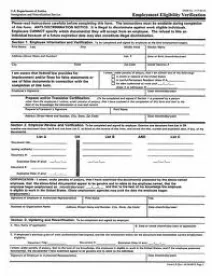The U.S. government has taken a huge leap forward this week in modernizing the Form I-9 process.
Starting August 1, 2023, the Department of Homeland Security (DHS) will allow qualifying employers to review I-9 documents using a video conference as part of the employment verification process. Please click here for the final rule as published in the Federal Register.
To learn more about this development as well as the requirements for employers to perfect inspection of documents for Forms I-9 completed under temporary COVID I-9 policies, please click here to register for our webinar on Friday, July 28.
Background
Since November 1986, employers have been required to verify the identity and employment authorization of new hires by completing Form I-9, reviewing related employee documents in-person, and confirming the documents reasonably appear to be genuine and relate to the employee.
The I-9 process, however, has failed to keep pace with rapid advancements in technology. While many employers have transitioned to electronic I-9 systems – completing and storing the forms electronically as an alternative to filling out and maintaining hard copy forms – DHS inspection and compliance guidance has been largely grounded in the paper Form I-9 process. Even as electronic I-9 completion became more widely adopted and, notwithstanding that the technology for virtual document review has been in place for several years, the government has long taken the position that “physical” I-9 document review required in the regulations means “in-person” document review.
COVID-19 Moved the Needle
In March 2020, when only essential employees were physically working at worksites, DHS announced flexibilities in the I-9 process that were driven by the COVID-19 national emergency. Under these “flexibilities,” DHS permitted temporary virtual document review, with the requirement that employers would conduct a future in-person I-9 document review.
As the pandemic dragged on and many companies and employers remained remote, a silver lining emerged. DHS identified the temporary flexibilities as a lesson in the possible future of I-9 verification and took concrete steps toward a post-COVID world where employers could permanently complete I-9 document review virtually.
Permanent Virtual I-9 Document Review – An Option as of August 1
Effective August 1, 2023, DHS amended the I-9 regulations through a final rule to authorize an optional alternative for examining the documents presented for Form I-9, waiving the 30-day effective rule timeline normally required under the Administrative Procedures Act. DHS also provided a specific optional alternate procedure through a concurrent Federal Register notice that outlines the conditions through which employers can complete the I-9 document review via live video conference.
To take advantage of this option, employers must:
Be enrolled in E-Verify in good standing.
Examine copies of documents for new employees and conduct a live video meeting with the employee during which they review the same documents.
Obtain and maintain clear and legible document copies (front and back).
Undergo specific trainings available in the E-Verify system.
Affirmatively note on the Form I-9 that they have conducted the I-9 document review using the alternative procedure.
DHS has determined these conditions equate to the level of security of physical in-person document inspection.
The option to meet the required conditions and review documents on video is entirely voluntary. Employers will still be able to complete the I-9 document review process in-person.
If an employer chooses to offer the alternative procedure to new employees at an E-Verify hiring site, the employer must do so consistently for all new hires at that site. However, an employer can elect to offer the alternative procedure for remote hires only and continue to complete in-person document inspection for employees working onsite or in a hybrid capacity. Employers cannot force employees to complete the video I-9 document review if the employee elects to provide documents in person.
This is a huge win for employers hiring employees in fully remote roles.
New Form, New Box
As part of the Final Rule, DHS is releasing a new version of Form I-9 on August 1 which is required for all employers across the board no later than November 1, 2023. Among other updates, the form includes a new box that an employer (or authorized representative) must check if the employer uses the alternative procedure.
An Employer Cost/Benefit Assessment
Employers must weigh the pros and cons for their organizations in utilizing the live video meeting document review option. It will be tempting for many to start this process as early as next week, but it’s critical for employers to create a strong framework for compliance at the outset. If an employer rushes into a change in procedure, one error in the process could create liability for all forms moving forward.
At this point, interested employers should be asking the following questions:
Are we enrolled in E-Verify?
If so, are we in “good standing”?
What are the hiring sites where we are enrolled in E-Verify?
Have our employer contacts who will be completing the I-9 completed the required trainings on document fraud and discrimination offered through E-Verify?
How would we use the video option?
Would we use it at all or some hiring sites?
Would we use it for all new hires or just remote workers?
What will be our method of secure document transfer?
How will we communicate to employees about expectations and process for the I-9?
Will any changes trigger the specific regulatory requirements for electronic I-9 creation and storage?
The final rule is clear that DHS will be reviewing and assessing data about Form I-9 compliance under the alternative procedures, and employers should expect close review on eligibility in the context of a potential future I-9 inspection. Rushing into virtual review without a clear compliance assessment and plan may have serious consequences if an error is caught down the road.
What About the COVID Forms?
Since March 2020, DHS issued a series of announcements extending the temporary virtual I-9 option. They announced in October 2022 that the temporary COVID flexibilities will sunset as of July 31, 2023, and in May 2023 provided an August 30, 2023 deadline for employers to complete required physical inspection for I-9s created under the temporary policy.
Under the final rule, employers that created forms under the COVID temporary I-9 flexibilities are not absolved from the required follow-up document review. (This would have been nice but is not a surprise. The temporary flexibilities lacked a required live video meeting and did not require E-Verify participation, two critical requirements in the final rule.)
If they have not already done so, employers that used the temporary virtual option, must complete I-9 document inspection under the terms and timelines provided by DHS under its temporary flexible remote review directives. Employers must complete in-person document review, unless eligible under a new limited exception provided in the final rule where certain E-Verify employers that completed the Form I-9 between March 20, 2020 and July 31, 2023, in compliance with the temporary COVID flexibilities and E-Verify case creation requirements, may use the alternate video document inspection process, as conditioned and outlined in the final rule.
Employers should work closely with qualified counsel to assess options and execute a plan with related compliance guidance and oversight to meet their specific needs. The Form I-9 can be completed and maintained in hard copy, electronically, or a combination of both. Employers that normally use an electronic vendor are not precluded from having remote employees complete a paper form update with an authorized representative in the next few weeks.
It's a Brave New I-9 World. Plan Accordingly.
Employers have faced incredible challenges over the past few years. DHS has been clear that it will be reasonable in assessing compliance during the COVID-19 pandemic and consider all related circumstances and factors that relate to an employer’s I-9 records during that time. This final rule is a good example of the same, but employers should not expect a pass for these forms on the required follow-up document inspection and form updates.
Employers should be familiar with their systems and processes and be careful not to confuse and/or conflate the concepts of electronic I-9s and virtual I-9 document review when assessing compliance practices. Electronic form completion (populating, signing, and storing the Form I-9 outside of the paper form format) is governed by a set of regulations with specific requirements on document creation and retention, including an I-9 “audit trail” and around the digital signature.
Form I-9 paperwork violations may result in I-9 related fines as high as $2,701 per form under current fine levels, which will increase in the future. Employers are liable for fines in place when a notice of intent to fine is issued, not when the violation first occurred.



 />i
/>i
